Grona setigera
Grona setigera (E.Mey.) H.Ohashi & K.Ohashi (= Desmodium setigerum (E.Mey.) Benth. ex Harv.)
Family: Fabaceae
Common names: bristly tick-clover (Eng.); pomo, pomσ (Mende, Sierra Leone)
Introduction
Grona setigera, commonly known as bristly tick-clover, is a beautiful legume that grows close to the ground, with remarkable, beautiful, colourful flowers that change colour after pollination, although it has the ability to reverse the colour change to allow second chance at pollination, which is why it is also known for being the shapeshifter or trickster. The flowers are mostly visited by various bee species for pollination.
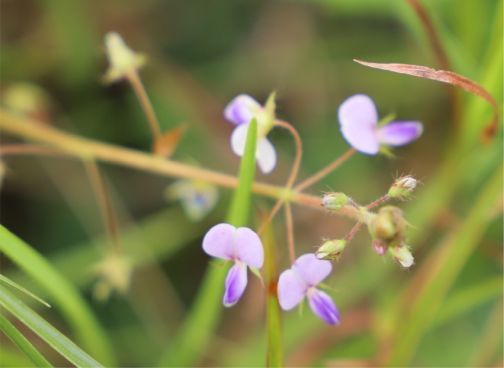
Description
Description
Grona setigera is an herbaceous, scrambling perennial that grows flat on the ground, with stems up to about 1.5 m long, rooting at lower nodes (Schrire 1988; Schrire 1984; Stanley et al. 2016). Stems sticky, branched, prostrate, covered with fine soft hairs, almost angular and faintly ridged (Schrire 1984). Leaves are trifoliate, leaflets egg-shaped, narrower at the base with a rounded leaf tip apex and base, covered with soft hair on both side of the leaflet (Schrire 1988). Stipels broad at the base and narrow towards the tip, setaceous and sparsely covered with soft hairs (Schrire 1984). Flowers in terminal spikes, violet, lilac, magenta, and pink to white (Stanley no date; Schrire 1988; Willmer et al. 2009). Flowers appear from midsummer to autumn (December to May), open for a day, after tripping by insect visitors to expose reproductive parts (Schrire 1988; Willmer et al. 2009). Fruit sticky, with about 6 U-shaped articles about 1–2 mm wide, covered in short hairs and marked with veins like a net (Stanley no date, Schrire 1988). Seed compressed, kidney-shaped, yellow brown (Schrire 1984).
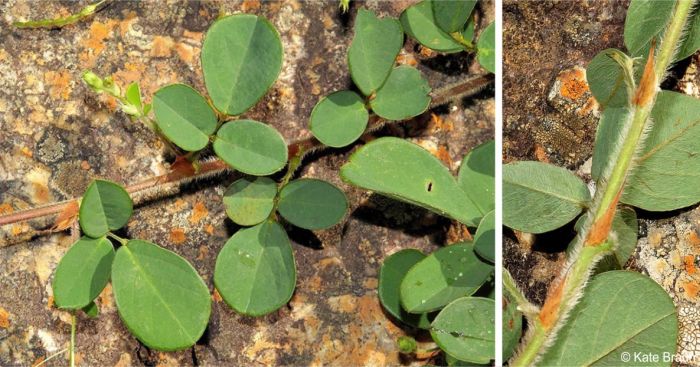
Grona setigera is known for its interesting flowers, which are various shades of pink or lilac, but the primary colour changes after pollinators visit the flower, indicating that the flower has been visited and pollinated (Stanley et al. 2016; Stanley no date). Although the flowers of G. setigera only last for one day, some of the flowers have been observed to re-open later in the day to allow a second chance at pollination (Willmer et al. 2009).
Conservation Status
Status
Grona setigera is distributed and native in southern, eastern, western and northern Africa and is assessed as Least Concern (LC) in the Red List of South African Plants, meaning it is not under threat in the wild, it is growing widely and its population is healthy (Foden & Potter 2005).
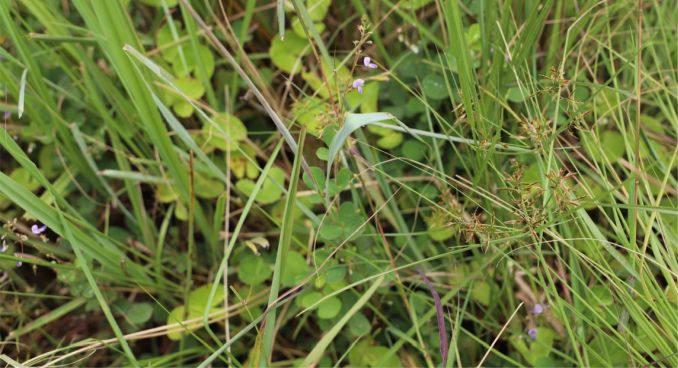
Distribution and habitat
Distribution description
Grona setigera is widely distributed in tropical African countries including South Africa (POWO 2023; Schrire 1984; Schrire 1988). In South Africa, it is mostly found in subtropical and coastal regions such as Limpopo, Mpumalanga, KwaZulu-Natal and Eastern Cape (Schrire 1988). Grona setigera plants are found in open grasslands, streambanks, forest margins, dry rocky hillsides and in semi-disturbed habitats, on roadsides (Schrire 1988). According to Schrire (1984), G. setigera prefers moist areas, such as swamps and depressions.
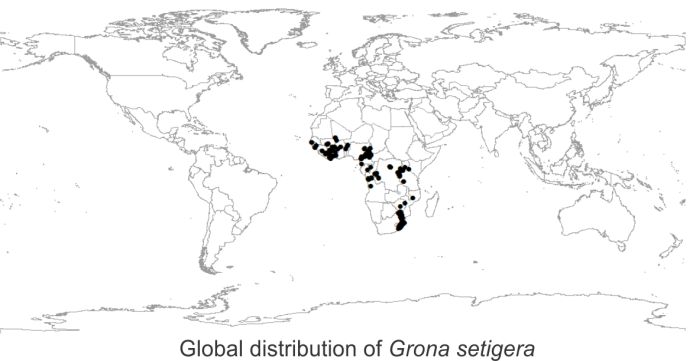
Derivation of name and historical aspects
History
Grona setigera, previously known as Desmodium setigerum (E.Mey.) Benth. ex Harv., is a species from the Desmodium group of the subtribe Desmodiinae, tribe Desmodieae. The tribe Desmodieae comprised of two subtribes, Desmodiinae and Lespedezinae in southern Africa (Schrire 2005). The subtribe Desmodiinae, is represented by three genera in southern Africa, which includes the Desmodium group (Schrire 1988). The Desmodium group includes about 20 genera, including Desmodium genus. The name Desmodium was conserved over the name Meibomia by the International Botanical Congress of Vienna in 1905. The name Desmodium is derived from the Greek desmos meaning ‘a band or chain’, and hode meaning ‘like’, in reference to the resemblance of the jointed pods to the links of a chain (Schrire 1988). Through recent molecular studies, the Desmodium genus has been found to be polyphyletic, with individuals that are derived from different ancestors (Ohashi et al. 2018). These molecular studies on the Desmodium genus have led to the foundation of new genera, and the resurrection of an old genus Grona (Ohashi et al. 2018).
The genus Grona Lour. has about 41 species, it was separated from the genus Desmodium in 2018 and includes the subgenus Sagotia which was divided into six sections and the sections Nicolsonia and Sagotia were further separated as the genus Grona (Ohashi et al. 2018). The name Grona is derived from the Greek grone, meaning ‘a cavern’ or gronos, meaning ‘eaten out’ (Jaeger 1944). The species name setigera means ‘bearing bristles’ (Pooley 1998). These plants are commonly called ‘tick-clover’ because their leaves resemble those of clover (Trifolium repens) and their sticky seed pods cling to passers by like ticks.
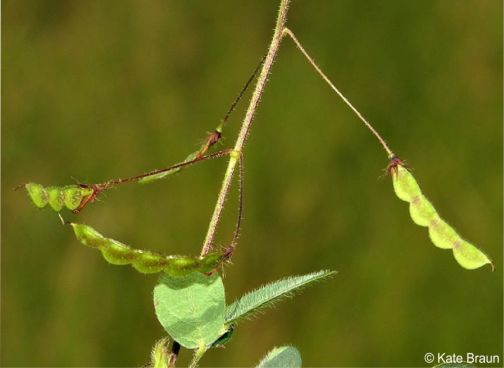
Ecology
Ecology
Pollination is generally defined as the transferring of plant pollen grains from the male part (anther) to the female part of a flower (stigma), with an intention of reproducing more plants (Waser et al. 1996). According to Stanley et al (2016), pollination is a mutual benefit for plants and pollinators, where plants gain the service and pollinators get food as a reward from plants. Many legumes have been found to have evolved flowers with explosive pollination mechanism (Stanley et al. 2016). Different pollinators have also been reported to activate or trigger the explosive mechanism, such as, bees, birds, flies, butterflies, moths and sometimes wind (Willmer et al. 2009). Many species in the tribe Desmodieae have been found to have explosive mechanism for pollination, including G. setigera (Schrire, 1984).
Grona setigera is observed to exhibit a change in flower colour after being pollinated. The flowers are mostly visited by different bee species for pollination to take place. An explosive mechanism happens on G. setigera flowers during the pollinator’s visitation (Stanley et al. 2016; Willmer et al. 2009). When the pollinator lands on the keel part of the flower and probes for nectar, it disturbs or trips the flower, which exposes the reproductive parts of the flower, the anthers and stigma, and pollen is released on the visitor (Willmer et al. 2009). When a flower has been visited by the pollinator, its colour changes rapidly from lilac to white, but if it is unvisited, the flower changes colour slowly, with lilac persisting throughout the day becoming dark turquoise (Willmer et al. 2009). The colour change of the flowers is believed to be a signal to pollinators that the flower has been visited and nectar is no longer available, as a result, nectar is not wasted as it is very costly for the plants to produce (Stanley 2016). Flowers of G. setigera that are visited early in the morning but not adequately pollinated allows a second chance of pollination later in the day, where the plant is able to reverse the colour change, signalling to insects that nectar is available, so that the flower can be revisited when pollination was not successful on the first visit (Willmer et al. 2009).
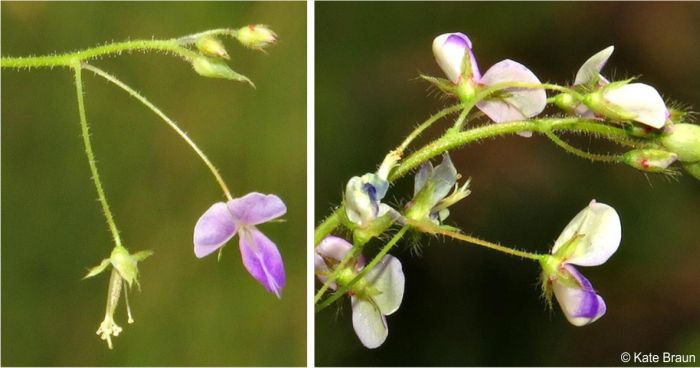
Uses
Use
According to Ma et al, plants of Desmodium have a long history of medicinal use in traditional Chinese medicine, treating ailments such as rheumatism, pyrexia, wounds, cough, malaria, hepatitis, dysentery and hemoptysis and plants are known to contain compounds such as flavonoids, alkaloids and many more, which are responsible for treating ailments such as internal heat or fever, to neutralize toxins, and inhibit pain, invigorate blood circulation, suppress cough and alleviate dyspnea. Cueva-Chamba does not report any medicinal usage of Desmodium species in South Africa, only in other countries.
According to Burkill, medicinal usage of Grona setigera is under documented, and plants are easily confused with Grona hirta, which is used to treat epileptic children, vertigo and kidney pains, and it is thus possible that usage of G. setigera could be similar to that of G. hirta, but this needs to be investigated. According to Cueva-Chamba, Desmodium species are highly used for medicine in different parts of the world, and whole plants of G. setigera are used for hemorrhoids.
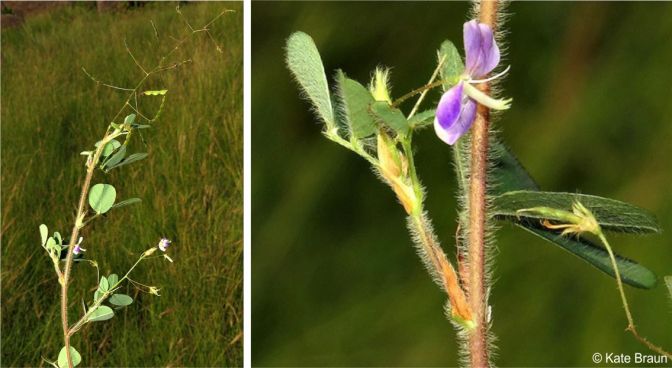
Growing Grona setigera
Grow
Grona setigera is an attractive herbaceous plant with beautiful flowers, however it has not been reported that the plant is grown in gardens or propagated in nurseries.
References
- Al-Obaydi, W.H., Younes, H.H. & Ayyash, L.M. 2021. Plants are talking their own languages. Annals of the Romanian Society for Cell Biology 25(6):9253-9261.
- Braun, K. 2023. Observations of Grona setigera. iNaturalist. Online. https://www.inaturalist.org/observations?place_id=any&taxon_id=1275070&user_id=katebraunsd.
- Burkill, H.M. 1985. Entry for Desmodium setigerum (E.Mey.) Benth. ex Harv. In: The useful plants of West tropical Africa Vol 3. Royal Botanic Gardens, Kew.
- Cueva-Chamba, A. et al. 2023. Traditional medicinal uses and biological activities of species of the genus Desmodium: a literature review. Boletín Latinoamericano y del Caribe de Plantas Medicinales y Aromáticas 22(6).
- Foden, W. & Potter, L. 2005. Desmodium setigerum (E.Mey.) Benth. ex Harv. National Assessment: Red List of South African Plants version 2020.1. Accessed on 2023/10/25.
- GBIF, Global Biodiversity Information Facility. Distribution of Grona setigera occurrence search. https://www.gbif.org/occurrence/search?taxon_key=10732003. Map downloaded 25 Oct. 2023.
- Hiroyoshi, O. & Kazuaki, O. 2019. Desmodium (Leguminosae tribe Desmodieae) of Africa, Madagascar and the Mascarene islands. Journal of Japanese Botany 94(3):135-148.
- Jaeger, E.C. 1944. A source-book of biological names and terms. Charles C. Thomas, Springfield.
- Ma, X., Zheng, C., Hu, C., Rahman, K. & Qin, L. 2011. The genus Desmodium (Fabaceae)-traditional uses in Chinese medicine, phytochemistry and pharmacology. Journal of Ethnopharmacology 138(2):314-332.
- Ohashi, K. et al. 2018. Phylogenetic analyses for a new classification of the Desmodium group of Leguminosae tribe Desmodieae. Shokubutsu Kenkyu Zasshi 93(3):165-189.
- Plants of the World Online. Entry for Grona Lour. https://powo.science.kew.org/taxon/urn:lsid:ipni.org:names:22526-1. Accessed 2 Nov 23.
- Pooley, E. 1998. A field guide to wild flowers Kwazulu-Natal and the eastern region. Natal Flora Publications Trust, Durban.
- Schrire, B.D. 1984. A taxonomic revision of the tribe Desmodieae (Leguminosae-Papilionoideae) (Doctoral dissertation).
- Schrire, B.D. 1988. A synopsis of the tribe Desmodieae (Fabaceae) in southern Africa. Bothalia 18(1):11-24.
- Stanley, D. no date. Functional ecology of colour change and breeding biology in Desmodium setigerum (E. Mey.). Project report.
- Stanley, D.A., Otieno, M., Steijven, K., Berlin, E.S., Piironen, T., Willmer, P. & Nuttman, C. 2016. Pollination ecology of Desmodium setigerum (Fabaceae) in Uganda; do big bees do it better?. Journal of Pollination Ecology 19(7):43-49.
- Waser, N.M., Chittka, L., Price, M.V., Williams, N.M. & Ollerton, J. 1996. Generalization in pollination systems, and why it matters. Ecology 77(4):1043-1060.
- Willmer, P., Stanley, D.A., Steijven, K., Matthews, I.M. & Nuttman, C.V. 2009. Bidirectional flower color and shape changes allow a second opportunity for pollination. Current Biology 19(11):919-923.
Credits
Mbali Mkhize
National Herbarium, Pretoria
November 2023
Acknowledgements: the author thanks Kate Braun for making her images of Grona setigera available via iNaturalist.
Plant Attributes:
Plant Type: Ground Cover, Perennial, Scrambler
SA Distribution: Eastern Cape, KwaZulu-Natal, Limpopo, Mpumalanga
Soil type: Sandy, Loam
Flowering season: Late Summer
PH:
Flower colour: White, Pink, Mauve/Lilac
Aspect: Full Sun
Gardening skill: Average
Special Features:
Horticultural zones








Rate this article
Article well written and informative
Rate this plant
Is this an interesting plant?
Login to add your Comment
Back to topNot registered yet? Click here to register.